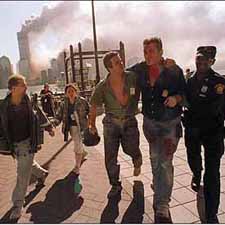Rutgers criminal justice instructor Mark Desire heads World Trade Center's forensic identification unit for the New York City medical examiner's office
A decade after the September 11, 2001, terrorist attack, the remains of four out of ten people who lost their lives at Ground Zero,

Desire: Yes, there are more than 21,000 remains recovered from ground zero. All had previous DNA work attempted multiple times. But 9,000 remains were too badly damaged or too small to have been successfully identified with previous technology. Today, we are using more advanced methods developed specifically to help identify those remains previously impossible to do.
Rutgers Today: Has the identification process changed over the past decade and how difficult is it to make a match a decade later?
Desire: The process is more sensitive. We are able to work with smaller amounts of DNA and isolate more from very small and degraded samples. The DNA analysis is made by comparing the genetic profile of the remains with victims’ personal possessions like hairbrushes and tooth brushes or from DNA samples provided by relatives.
Rutgers Today: When you make a positive identification, what happens next?
Desire: We abide by the family's wishes, if they want to be notified or not. The remains are either returned to the family or stored until the September 11 Memorial Museum repository is ready. The remains repository – which is scheduled to receive remains in 2013 and not be open to the general public -- will be adjacent to the museum’s memorial exhibition, which will honor the lives of those who were lost and allow visitors to learn about the victims through photographs, personal remembrances, and mementos donated by family and friends. In the last five years we have made 26 new identifications. The most recent was in August, when the remains of a 40-year-old man who worked in the trade center’s north tower were identified.
Rutgers Today: Has your involvement in helping to identify the victims of 9/11 changed you in anyway?
Desire: As a forensic scientist you are trained to not become personally involved in your work and to remain impartial, unbiased and neutral. That is impossible in the forensic work we are doing at the World Trade Center. We all have feelings for what happened that day. The New York City Office of Chief Medical Examiner and the DNA Crime Lab are as committed to this work today as we were 10 years ago.
Rutgers Today: Do you use your experience and what you have learned from 9/11 in the classroom at Rutgers?
Desire: The work and experience from 9/11 has helped not only to identify victims from 10 years ago but also assists us in our everyday body identification and missing person cases. We can do things today that we could not back then. Agencies from all over the world working in criminal justice have benefited from our research. This has been a valuable lesson not only in the science of identifying remains but also in the importance of working together and sharing the knowledge with others that we have learned as a result of this tragedy.
Robin Lally
Media Contact: Robin Lally
732-932-7084, ext. 652
E-mail: rlally@ur.rutgers.edu